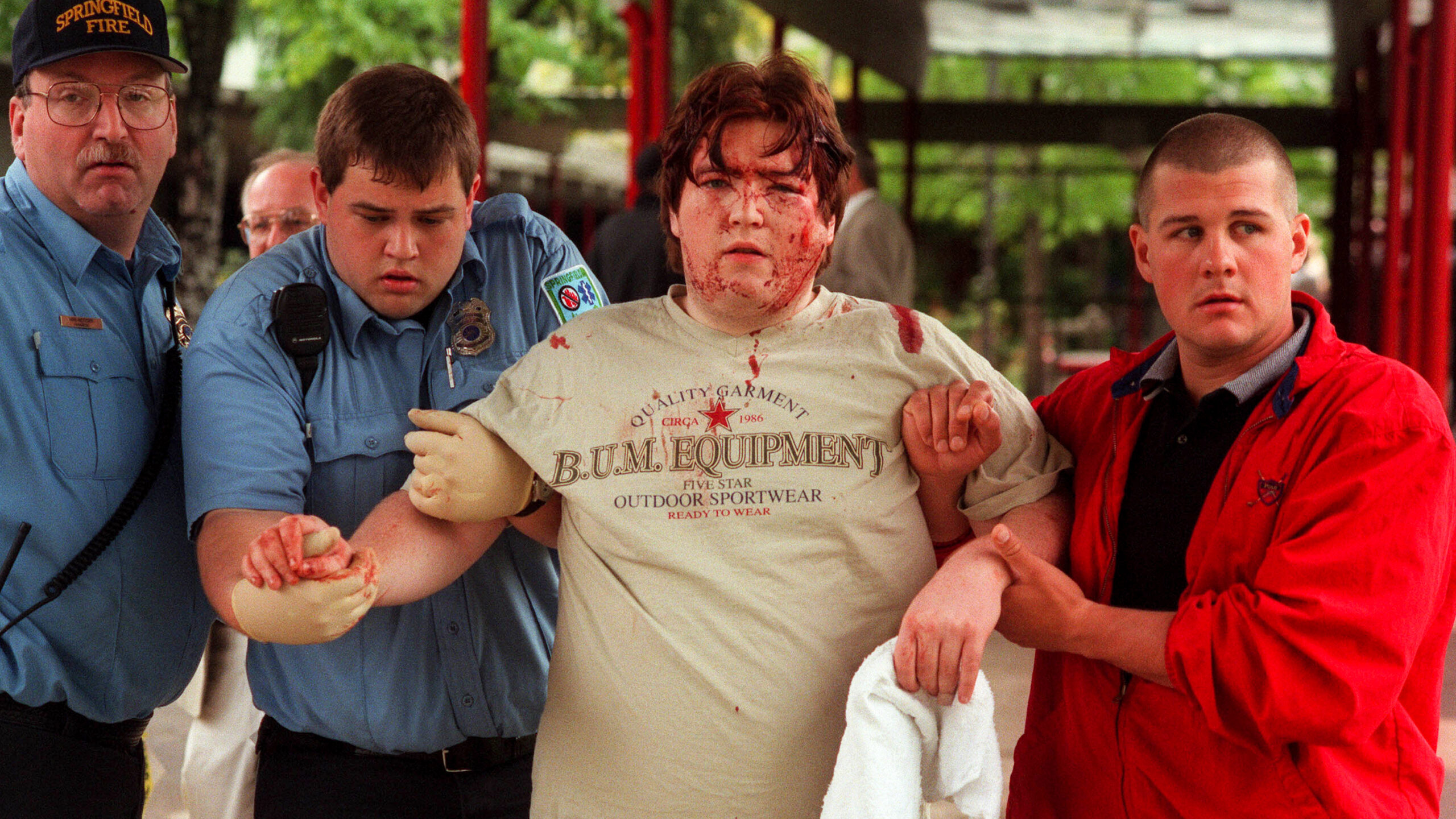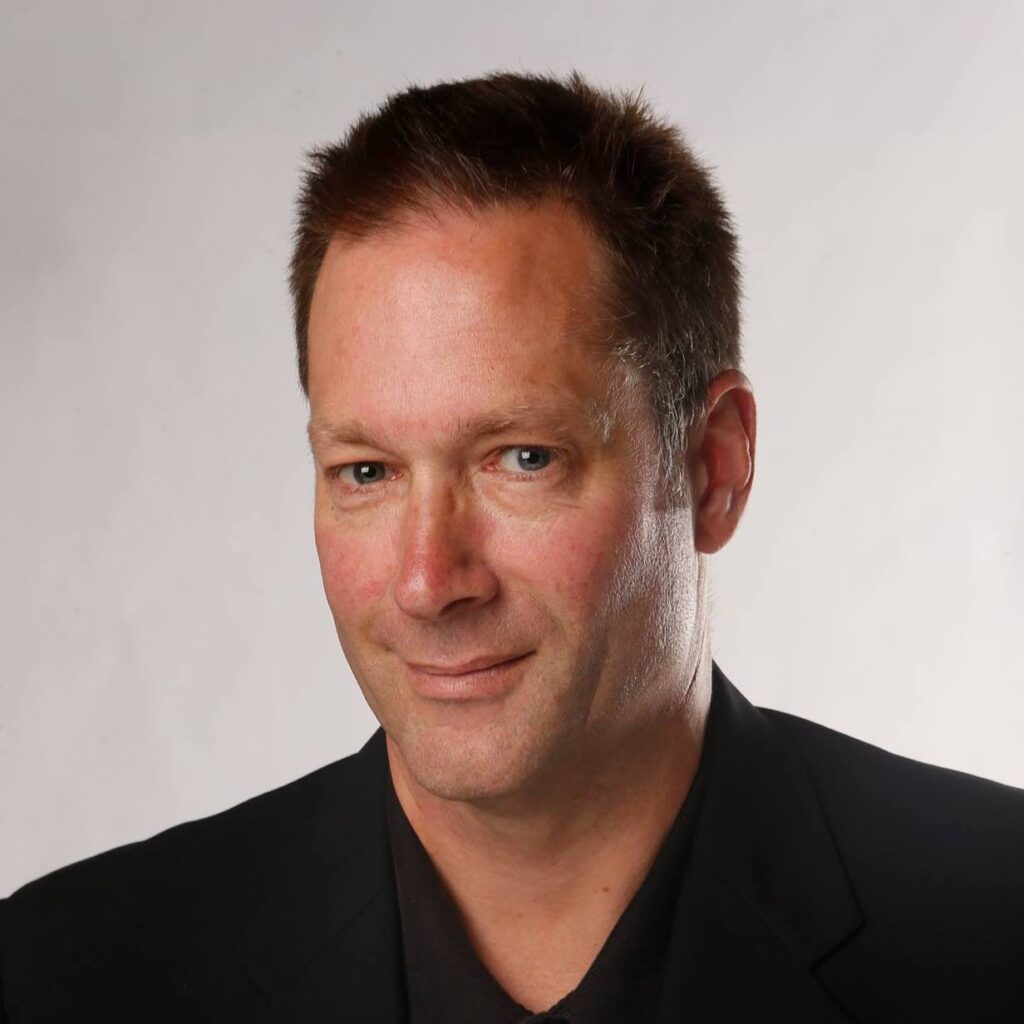‘This was our town … these are our people’

1997-2007
By Mark Baker
For The Register-Guard
You can’t talk about this era, unfortunately, without talking about what is arguably the biggest and most important story The Register-Guard has ever covered: Thurston.
That’s all you need to say.
It’s been almost 20 years since 15-year-old Kip Kinkel killed his parents, Bill and Faith Kinkel, on May 20, 1998, and then opened fire on his Thurston High School classmates while they were eating breakfast in the cafeteria just before 8 a.m. the next day, killing two, Mikael Nickolausen, 17, and Ben Walker, 16, and injuring more than two dozen others.
“It happened here,” reporter Eric Mortenson wrote in the lead story of May 22, 1998.
The lead photograph, by Paul Carter, was a terrifying image of 17-year-old Ryan Atteberry, his face spattered with blood, his eyes staring right into Carter’s lens – the left one swollen by the bullet that had lodged near it.
A medic held Atteberry’s right arm, and a substitute teacher, who had been on campus all of 10 minutes, held his left arm as they hurried him to a waiting ambulance.

“Tragedy hits home,” read the banner headline.
President Bill Clinton would visit Thurston 23 days later to offer healing words.
The Register-Guard focused its coverage on how to help the community heal, creating a logo, “Healing the Heartbreak,” to accompany all stories.
“We understood that this was our town and these are our people,” says Carl Davaz, The Register’s deputy managing editor, who was in charge of the photo staff that day. “And we needed to be sensitive to that, because we were at home.”
In April 1999, the photo staff, including Carter, Davaz, Chris Pietsch, Nicole DeVito and Rob Romig, would be named one of three finalists for the Pulitzer Prize in spot news photography “for its coverage of a community recoiling then recovering from a brutal shooting spree at a local high school.” That is the only time The Register-Guard has been named a finalist for journalism’s most prestigious award.
The Pulitzer that year went to The Associated Press, for images taken following the embassy bombings in Kenya and Tanzania on Aug. 7, 1998.
Certainly, there was pride among the staff in such a rare accomplishment, but Davaz remembers only muted reflection upon hearing the news.
“I think, given what the reason was, it was fairly subdued,” he says of the staff’s reaction to being named a Pulitzer finalist.
The Register-Guard compiled its Thurston coverage – some of which was reported on registerguard.com, its new website that it launched in December 1997 – from 3500 Chad Drive, which had been its new home for all employees for just four months, since January 1998, 3 years after its new production plant had opened at the same location.
“A building for the future,” was the headline on the special section that ran on Jan. 25, 1998. It told the story of the spacious new $10.6 million, 87,000-square-foot office building that had a newsroom “the length of a football field,” new furniture, computers and everything else, including a cafeteria where employees could buy a catered lunch.
A company that now had 455 full- and part-time employees could breathe again.
“We were stacked like cordwood in the downtown office and had people working in hallways and what used to be storage closets,” said Jim Godbold, then the newspaper’s managing editor.
Spending $40 million total on the new press, production and office buildings “underscores our long-held philosophy that we believe the community is best served by a locally owned newspaper,” Editor and Publisher Tony Baker said. “It’s the family’s intention to continue to own and operate the paper in that manner for years to come.”
The news staff, which numbered about 80 full-time employees then, more than twice what it is in 2017, was busy during this 10-year period covering stories about former South Eugene and Stanford golfer (and future UO golf coach) Casey Martin’s lawsuit (which he ultimately won in 2001) against the PGA Tour for his right to use a golf cart because of a degenerative disorder in his leg, a case that went all the way to the U.S. Supreme Court; about Eugene City Manager Vicki Elmer, who was embroiled in conflict with a City Council that eventually fired her in March 1998; and about the New Carissa, the Japanese freighter that broke apart on Feb. 4, 1999, during a storm and ran aground near Coos Bay.

The banner headline in the June 18, 1999 Register-Guard was: “Parade escalates into rampage.” The anarchist movement in Eugene had heated up again with a five-hour march in downtown Eugene as masked youth and others broke store windows, threatened motorists, beat on cars and threw rocks in a protest against capitalism.

The big, bold headline on Jan. 1, 2000, read: “Y2K OK.” Concerns that electronic chaos would break out worldwide because some computers would read “2000” as “1900” were unfounded.
All was not always OK, though, in the new century.
It brought eco-terrorism to Eugene, the Sept. 11 terrorist attacks on the East Coast – “Unthinkable,” read the Sept. 12, 2001, Register-Guard headline – and the death of Ken Kesey in November 2001.
“We’ve lost our Merry Prankster,” read the lead on the front-page news obituary co-bylined by reporters Bob Keefer and Susan Palmer.
Then there was John Musumeci, the Eugene developer The Register-Guard tabbed “Dealmaker” in 2001, whose biggest deal was assembling $18 million worth of property from several parcels on a bend in the McKenzie River in Springfield, then selling it to PeaceHealth for its new Sacred Heart Medical Center at RiverBend for $34 million.
There were the arrests and convictions of Eugene police officers Juan Lara and Roger Magana in 2003-04, on charges of raping, sexually assaulting and harassing multiple women while on duty
And there was the election of left-leaning Kitty Piercy in 2004 over right-leaning incumbent Jim Torrey, the first of a record three elections Piercy would win.
In 2006, Bob Welch, The Register-Guard’s popular columnist, was named the nation’s best in the annual National Society of Newspaper Columnists contest after he mistakenly entered the wrong circulation category – “over 100,000,” instead of “under 100,000” – thus giving him the top award over columnists from larger newspapers such as the Pittsburgh Post-Gazette, the Kansas City Star, Denver’s Rocky Mountain News and The Oregonian.
Also in 2006, photographer Chris Pietsch’s spectacular picture of a gray jay landing – and looking right into his remote camera – at sunrise at Odell Lake took first place for science/natural history photography in the Pictures of the Year International competition.
Mark Baker, who researched and wrote the stories for this special section, is a former Register-Guard reporter and a member of the third generation of the Baker family.

Mark Baker has been a journalist for the past 25 years. He’s currently the sports editor at The Jackson Hole News & Guide in Jackson, Wyo.
